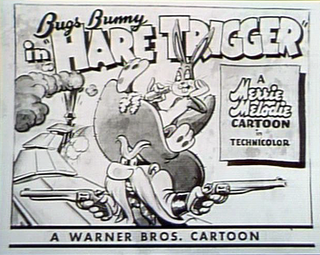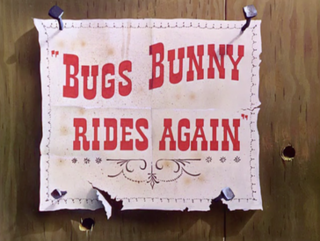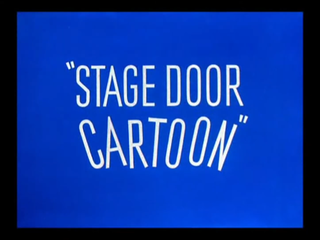Related Research Articles

Yosemite Sam is a cartoon character in the Looney Tunes and Merrie Melodies series of short films produced by Warner Bros. His name is taken from Yosemite National Park in California. He is an adversary of Bugs Bunny and his archenemy alongside Elmer Fudd. He is commonly depicted as a mean-spirited and extremely aggressive, gunslinging outlaw or cowboy with a hair-trigger temper and an intense hatred of rabbits, Bugs in particular. In cartoons with non-Western themes, he uses various aliases, including "Chilkoot Sam" and "Square-deal Sam" in 14 Carrot Rabbit, "Riff Raff Sam" in Sahara Hare, "Sam Schultz" in Big House Bunny, "Seagoin' Sam" in Buccaneer Bunny, "Shanghai Sam" in Mutiny on the Bunny, "Von Schamm the Hessian" in Bunker Hill Bunny, "Baron Sam von Schpamm" in Dumb Patrol, and many others. During the golden age of American animation, Yosemite Sam appeared as antagonist in 33 animated shorts made between 1945 and 1964.

Knighty Knight Bugs is a 1958 Warner Bros. Looney Tunes cartoon directed by Friz Freleng, The short was released on August 23, 1958, and stars Bugs Bunny and Yosemite Sam.

Falling Hare is a 1943 Warner Bros. Merrie Melodies cartoon directed by Bob Clampett. The cartoon features Bugs Bunny.

Hare Trigger is a 1945 Merrie Melodies cartoon directed by Friz Freleng. The cartoon was released on May 5, 1945, and features Bugs Bunny. The short featured the first appearance of Yosemite Sam, as well as the first short to credit (almost) the whole animation staff who worked on the short.
High Diving Hare is a 1948-produced Warner Brothers Looney Tunes theatrical cartoon short starring Bugs Bunny and Yosemite Sam. Released to theaters on April 30, 1949, the short is an expansion of a gag from Stage Door Cartoon, which was also directed by Friz Freleng, and co-stars Elmer Fudd. High Diving Hare can be seen in the third act of The Looney Looney Looney Bugs Bunny Movie, and a segment can be seen in the special Bugs Bunny's Wild World of Sports.

Bugs Bunny Rides Again is a 1948 Merrie Melodies animated short directed by Friz Freleng. The short was released on June 12, 1948, and stars Bugs Bunny and Yosemite Sam.

The Looney Looney Looney Bugs Bunny Movie is a 1981 American animated comedy package film with a compilation of classic Looney Tunes/Merrie Melodies Warner Bros. cartoon shorts and animated bridging sequences produced and directed by Friz Freleng, hosted by Bugs Bunny. The new footage was produced by Warner Bros. Animation. It was the first Looney Tunes/Merrie Melodies film with a compilation of classic cartoon comedy shorts produced by Warner Bros. Animation.

Buccaneer Bunny is a 1948 Looney Tunes cartoon directed by Friz Freleng. The short was released on May 8, 1948, and features Bugs Bunny and Yosemite Sam.

Stage Door Cartoon is a 1944 Merrie Melodies cartoon directed by Friz Freleng. The short was released on December 30, 1944, and features Bugs Bunny and Elmer Fudd.

Roman Legion-Hare is a 1955 Warner Bros. Looney Tunes animated short directed by Friz Freleng. The short was released on November 12, 1955, and stars Bugs Bunny and Yosemite Sam. The title is a play on the words Roman Legionnaire. After being ordered by Emperor Nero to find a victim to be tossed to the lions, Yosemite Sam tries to capture Bugs Bunny.
From Hare to Heir is a 1960 Warner Bros. Merrie Melodies theatrical cartoon short directed and written by Friz Freleng. The short was released on September 3, 1960, and stars Bugs Bunny and Yosemite Sam.

Sahara Hare is a 1955 Warner Bros. Looney Tunes theatrical cartoon short directed by Friz Freleng. The short was released on March 26, 1955, and stars Bugs Bunny and Yosemite Sam.
Piker's Peak is a 1957 Warner Bros. Looney Tunes animated short directed by Friz Freleng. The short was released on May 25, 1957, and stars Bugs Bunny and Yosemite Sam. The title is a pun on Pike's Peak, although that respected mountain summit is in North America rather than in Europe.
The Bugs Bunny Mystery Special is an animated television special that was broadcast on CBS October 15, 1980. Presented by Porky Pig as an Alfred Hitchcock-style whodunit, the plot is modeled after those of North by Northwest and The Fugitive.

This Is a Life? is a 1955 Warner Bros. Merrie Melodies animated cartoon directed by Friz Freleng, written by Warren Foster, and produced by Edward Selzer, with music directed by Milt Franklyn. The short was released on July 9, 1955, and stars Bugs Bunny. The voices were performed by Mel Blanc, Arthur Q. Bryan, and June Foray in her first work for Warner Bros. This is one of the few Bugs Bunny cartoons whose title does not contain Bugs, bunny, rabbit/wabbit or hare.

Devil's Feud Cake is a 1963 Warner Bros. Merrie Melodies animated short directed by Friz Freleng. The short was released on February 9, 1963, and stars Bugs Bunny and Yosemite Sam.
The Fair-Haired Hare is a 1951 Warner Bros. Looney Tunes cartoon starring Bugs Bunny and Yosemite Sam. Released April 14, 1951, the cartoon was directed by Friz Freleng. The voices were performed by Mel Blanc.

Hare Trimmed is a 1953 Warner Bros. Merrie Melodies short directed by Friz Freleng and written by Warren Foster. The short was released on June 20, 1953, and features Bugs Bunny, Yosemite Sam and Granny.

Wild and Woolly Hare is a 1959 American animated Western comedy short film directed by Friz Freleng and written by Warren Foster. The short was released on August 1, 1959 by Warner Bros. Pictures as part of the Looney Tunes series, and features Bugs Bunny and Yosemite Sam.
Horse Hare is a 1960 Warner Bros. Looney Tunes cartoon directed by Friz Freleng. The short was released on February 13, 1960, and stars Bugs Bunny and Yosemite Sam. It was the first Bugs Bunny cartoon released in the 1960s.
References
- 1 2 3 4 Webb, Graham (2011). The Animated Film Encyclopedia: A Complete Guide to American Shorts, Features and Sequences (1900-1999). McFarland & Company, Inc. p. 150. ISBN 978-0-7864-4985-9.
- ↑ Beck, Jerry; Friedwald, Will (1989). Looney Tunes and Merrie Melodies: A Complete Illustrated Guide to the Warner Bros. Cartoons. Henry Holt and Co. p. 242. ISBN 0-8050-0894-2.
- ↑ Lenburg, Jeff (1999). The Encyclopedia of Animated Cartoons. Checkmark Books. pp. 60–62. ISBN 0-8160-3831-7 . Retrieved 6 June 2020.
- ↑ 1634–1699: McCusker, J. J. (1997). How Much Is That in Real Money? A Historical Price Index for Use as a Deflator of Money Values in the Economy of the United States: Addenda et Corrigenda (PDF). American Antiquarian Society. 1700–1799: McCusker, J. J. (1992). How Much Is That in Real Money? A Historical Price Index for Use as a Deflator of Money Values in the Economy of the United States (PDF). American Antiquarian Society. 1800–present: Federal Reserve Bank of Minneapolis. "Consumer Price Index (estimate) 1800–" . Retrieved 29 February 2024.